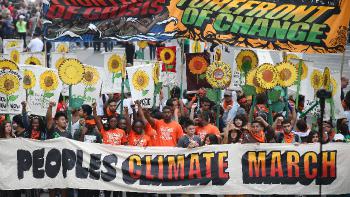NYC Day of Climate Protests a Step Forward

The last protest of the day of the New York City Climate Protests was at a Broadway theatre where Gov. Cuomo was scheduled to attend. It was a spirited demonstration complete with a little orchestra and playful costumes focused on persuading Cuomo to veto the Port Ambrose Liquefied Natural Gas (LNG) plant off the coast of Long Island right near JFK airport. Opponents argue that it is very dangerous security risk, terrible for the environment, and would kill the chance for a 700-megawatt wind farm that would create 17,000 local jobs.
When Cuomo arrived—in a mega SUV!—a protester and reporter cornered him. The governor said he had not yet decided about Port Ambrose but that, “he had concerns.” So do opponents “have concerns” and they promised to be back. The hope is that just as Cuomo was finally moved to ban fracking because of all the protestors dogging him at every public appearance, so too can he be pressured to ban the Port Ambrose LNG plant and approve a renewable energy alternative.
This was the third of three protests that took place in New York City, beginning on Wed., Oct. 14 and billed as a Climate Day of Action leading up to COP 21, the international climate meetings in Paris next month. The protests were organized by a coalition called the People’s Climate Movement (PCM), formed after the giant Peoples’ Climate March, with SEIU locals 1199 and 32BJ, AFSCME DC37 Climate Committee, ALIGN, Alliance for Climate Education, Climate Works for All, Community Voices Heard, Greenfaith, Make the Road, NY Communities for Change, NYC Environmental Justice Alliance, People’s Climate Arts, Rising Tide NYC, and System Change Not Climate Change, an eco-socialist coalition, all taking part.
As this broad range of sponsors suggests, the other two demonstrations had broader aims, focusing on the intersection of economic, racial and ecological injustice. At one point around two hundred people met in Midtown and marched to the offices of Chase Bank. The protesters decried Chase’s massive investments in coal, oil, and gas, as well as its one million-plus shares in private prisons, its role in the foreclosure crisis, and its support for the NY Police Foundation with a $4.6 million donation in 2011, the largest in the Foundation’s history.
Led by activists from Right to the City, NY Communities for Change, Homes for All, and Churches United for Fair Housing, much of the group then marched back to the office building housing the Blackstone Group, where the focus was on the right to housing. Blackstone has been instrumental in promoting subprime mortgages and housing activists in Spain and elsewhere had targeted them for protest on this day. Housing is an environmental issue in a broad sense, but it is tied to the ecological crisis through Hurricane Sandy, as a result of which many poorer families, (predominantly people of color, were displaced and many remain displaced.
Harlem’s State Office Building on 125th St. was the site of the second demonstration, which should have been the biggest both because it was held at 5:00 p.m. and because its institutional support. Joining issues of racial injustice with the economic and environmental crises, it had the support of SEIU 32BJ, DC 37, WEACT for Environmental Justice, the West Harlem Democratic Club, COPWATCH, residents from NYCHA, several churches, and the Raging Grannies. Banners proclaimed TO “CHANGE EVERYTHING WE NEED EVERYONE,” “GREEN JOBS,” and—probably the most popular—SCNCC’s banner “RACIAL INJUSTICE/CLIMATE INJUSTICE.” Speakers included State Senator Bill Perkins, the head of WEACT, a pastor from Greenfaith whose church in Far Rockaway was flooded by Hurricane Sandy, someone from NYCHA, and a person from COPWATCH.
The protest was a broad and promising effort. Unfortunately, the turnout was small. Given the organizational power behind it, this is odd. Surely these unions could have turned more people out if they had tried. One DC 37 member reported that she had only received one e-mail the day before. It’s one thing for a union to take a progressive position; it’s another thing to really educate, organize, and mobilize its members on behalf of the issue. Rank-and-file members who care about the environment, and its intersection with economic and racial injustice have their work cut out for them.